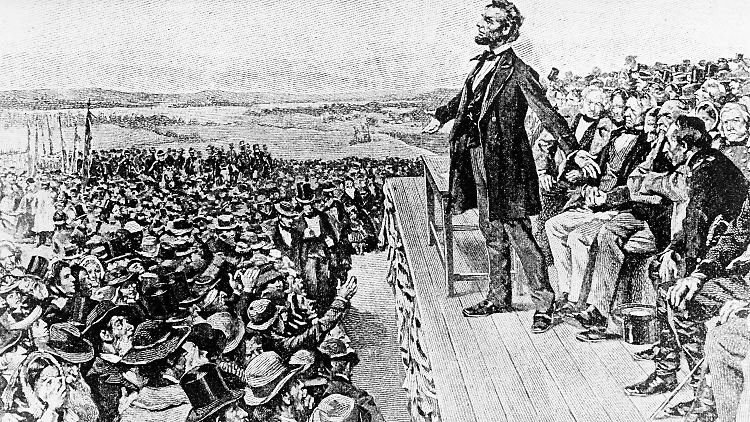In the summer of 1863, the bloodiest battle of the American Civil War raged near the small town of Gettysburg. For then US President Abraham Lincoln, the three-day slaughter is the reason for his most famous speech. To this day, the battle has a permanent place in US culture of remembrance.
It was only to be a brief appearance: on November 19, 1863, US President Abraham Lincoln traveled to Gettysburg to inaugurate the new military cemetery. Five months earlier, the bloodiest battle of the American Civil War raged around the small town in the state of Pennsylvania. When the keynote speaker finished his presentation, Lincoln addressed the assembled guests for two minutes.
With his Gettysburg Address, Lincoln outlined the American understanding of democracy. Numerous personalities such as Martin Luther King and John F. Kennedy later referred to them.
(Photo: AP)
In his brief address he urged his countrymen to swear “that these dead may not have died in vain, that this nation, under God, will see a rebirth of liberty, and that the government of the people, by the people and for the people , may not disappear from the earth.” The audience’s applause was muted and Lincoln was not satisfied either, probably due to the brevity of his performance. “It was a total letdown,” he is said to have said later. Little did he know then that his speech would go down in history. To this day, it shapes the self-image of the USA.
“Lincoln’s Gettysburg Address is one of the most important political documents of the 19th century. His speech is practically a renewal of the United States’ promises of democracy and freedom,” says Georg Schild, Professor of North American History at the University of Tübingen, in an interview with ntv.de . Without the Union victory at Gettysburg, the President’s appearance would probably never have taken place. “Gettysburg was one of the pivotal battles of the American Civil War. Some historians say the southern states never came so close to victory.”
“The cost of war should be inflated”
The civil war between the renegade southern states and the north had been raging since 1861. In the third summer of the war, exhaustion spread on both sides. “The South found it increasingly difficult to replace its losses, while the North feared that the population had no interest in a protracted war for such an abstract goal as the restoration of the Union,” said Schild. In this situation, Confederate General Robert E. Lee became convinced that only an invasion of the North would secure the independence of the slave-holding Southern states.
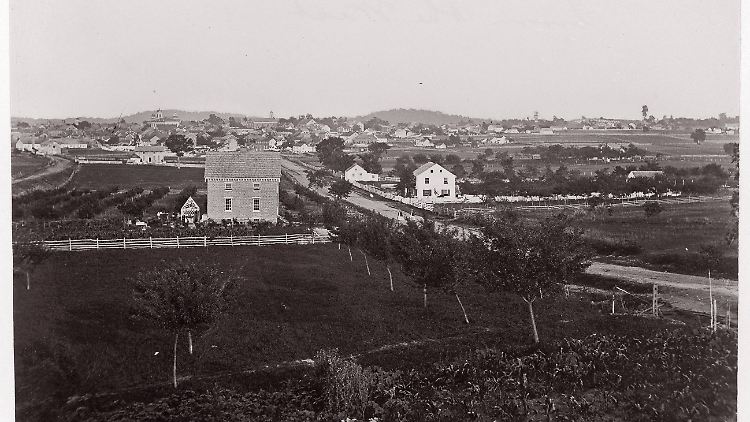
The city of Gettysburg was the scene of the fighting only by accident, because it was located at the crossroads of several streets. Photo from 1863.
(Photo: IMAGO/piemags)
“The goal was probably the occupation of Pennsylvania’s capital, Harrisburg, or the siege of Washington,” says Schild. “Lee wanted to make it clear that Lincoln was still a long way from a military victory. The costs of the war should be pushed up in order to persuade the North to engage in peace talks.”
In doing so, Lee ignored the miserable condition of his troops. The Army of Northern Virginia was the most ill-equipped and poorly supplied military force in 18th and 19th century history. Also numerically Lee was inferior with nearly 80,000 men of the Northern Potomac Army with about 115,000 men.
Nevertheless, in early June he set off through the Shenandoah Valley towards Pennsylvania. On June 28, Lee, who had been out of contact with his cavalry for some time, learned that the Army of the Potomac was already hot on his heels. He immediately ordered his scattered columns to assemble at Gettysburg, which was approached by a dozen roads from all directions.
Small skirmish develops into battle
Early in the morning of July 1, 1863, a Confederate brigade advancing into the city met the Army of the Potomac’s advance guard. What began as a small skirmish developed momentum of its own as more and more units from both armies reached Gettysburg.
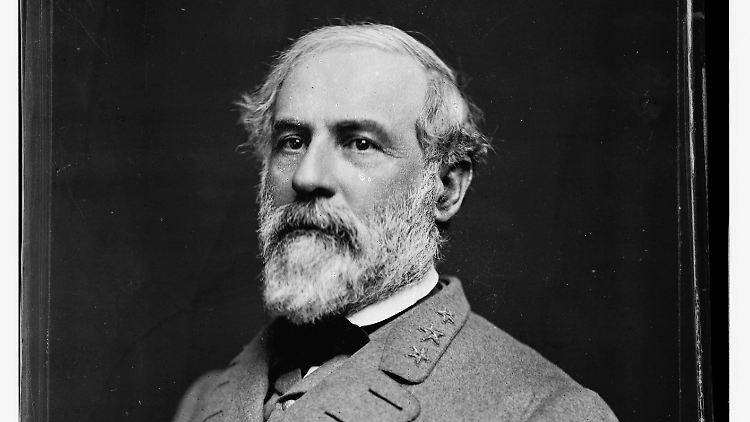
Lee was the most successful general in the Confederacy. He knew the South would never survive a long war. The attack on Gettysburg was intended to force a decision.
(Photo: picture alliance / akg-images)
There was total confusion because no one knew where the targets of the attacks were and what was being defended. Lee had warned his commanders not to seek combat until the army was united. Appearing on the battlefield in the afternoon, he changed his mind and threw all available units forward.
The Union troops then gave in and took refuge on Cemetery Hill southeast of the city. Gettysburg was now in Confederate hands. But Lee knew the battle wasn’t over as long as the enemy held the elevated ground.
Union troops hold the heights
As night fell, more and more Union troops poured onto the plateau. General George Meade, Commander-in-Chief of the Army of the Potomac, extended his line south to two rocky outcrops, Little Round Top and Big Round Top, and east to Culps Hill. As a result, its position resembled the shape of a fishing hook.
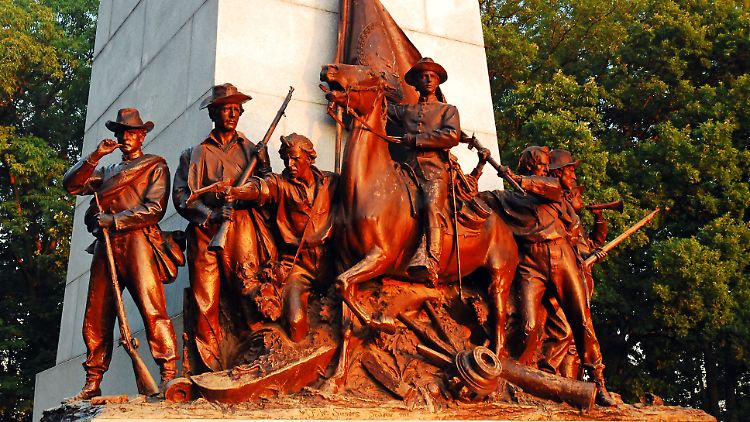
No other former battlefield has as many memorials as Gettysburg. There are about 400 in total – for the northern and southern states.
(Photo: imago images/James Kirkikis)
For the next day, Lee ordered an attack on the Union flanks. On the afternoon of July 2, the Southerners launched an attack, but the attacks were poorly coordinated. Meade quickly plugged any holes in his line. On Little Round Top, the 20th Maine Regiment formed the Union’s extreme left wing. When the unit ran out of ammunition, the defenders launched a bayonet charge with their empty muskets, driving the rebels back.
On the right flank, Lee’s men advanced far too late and made little ground gains. As night fell, the Army of the Potomac was still on the high ground southeast of the city.
Frontal attack turns into a disaster
The second day of the battle hadn’t gone as Lee had planned. But he still didn’t give up. Now he was planning a frontal attack on the center of the Union. Lee evidently believed that Meade had withdrawn troops from his midst to bolster the flanks. In fact, Cemetery Ridge continued to be heavily manned.
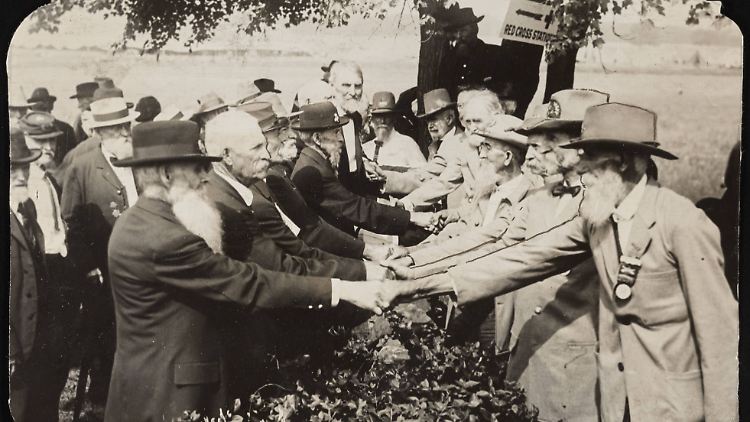
Gesture of reconciliation: Veterans from both sides shook hands in Gettysburg on the 50th anniversary of the battle.
(Photo: IMAGO/piemags)
At a little after 3 p.m., about 12,500 Southerners marched in a one-mile line across open country toward the entrenched Union regiments. After just a few meters, the concentrated defensive fire tore wide gaps in the formations. Only a few hundred rebels reached the stone wall on the ridge, where they were thrown back in hand-to-hand combat. The battle was lost. Lee took responsibility for the disaster to his subordinates. Two days later, in the pouring rain, his army began the march back to Virginia.
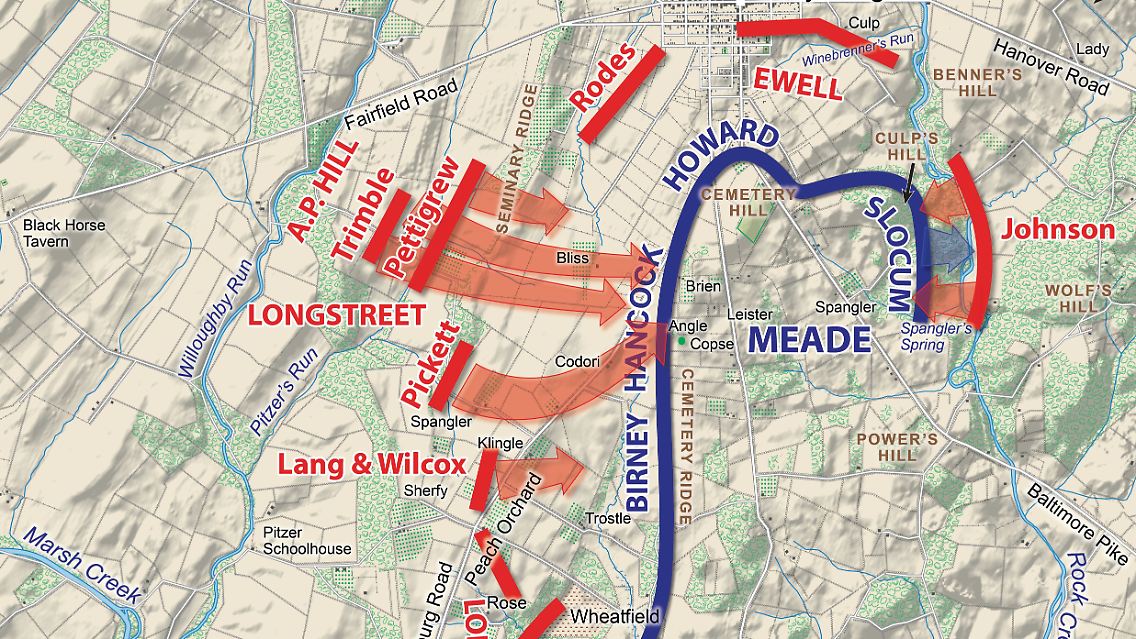
Situation Map: Day 3 of the Battle of Gettysburg (click for full-size view)
(Photo: Map by Hal Jespersen, www.cwmaps.com (CC BY 3.0))
Gettysburg was the costliest battle of the American Civil War: around 23,000 Union men were killed, wounded or reported missing. The Northern Virginia Army lost between 23,000 and 28,000 men, a loss from which it never recovered. Despite the Confederate defeat, the war raged on for two more years.
“After Gettysburg, a military victory for the Confederacy was no longer possible, especially since Union troops conquered Vicksburg on the Mississippi on July 4th. The Confederation was thus divided into two parts,” says Schild. “After Gettysburg, the offensive power of the South was exhausted. In this respect, the battle can be described as the turning point of the war.”
Monuments for the North and the South
As the war ended, Gettysburg, and the conflict in general, became the subject of a variety of interpretations. For Union veterans, the battle initially represented good versus evil, while the South painted a picture of a heroic struggle against overwhelming enemy power. Over time, the war was reinterpreted as a clash between two parts of the country to create a unified nation. The aspect of freeing slaves receded into the background.
“If you look at the Gettysburg battlefield today, you’ll find memorials to the fallen of both the North and the South,” says Schild. “Both sides are commended for the heroism with which they fought. Although that’s hard to understand given that the Southerners stood up for dividing the Union and maintaining slavery.”
With his Gettysburg speech, Lincoln summed up the American understanding of democracy. To this day, every schoolchild in the United States memorizes his plea for freedom and democracy. Numerous politicians and personalities such as John F. Kennedy or Martin Luther King later referred to the text.
“Gettysburg is now seen as a warning example of the internal conflicts in the USA,” said Schild. “At the same time, connected to the battle and Lincoln’s speech is the idea that despite differences of opinion and past opposition, there is hope for healing and reconciliation.”
